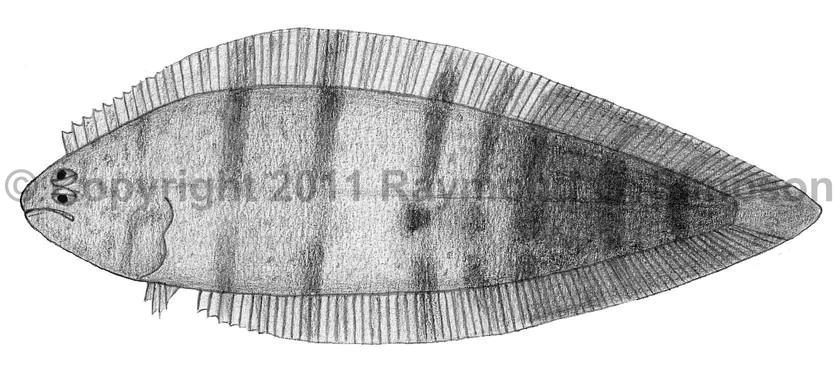
Common Name
Patchtail Tonguefish
Year Described
Böhlke, 1961
Identification
Dorsal Fin Rays: 83-87
Anal Fin Rays: 68-71
Pectoral Fin Rays: none
Pelvic Fin Rays: 4
Caudal Fin Rays: 12
Longitudinal Scale Rows: 91-97
Vertebrae: 46-48
Pterygiophore pattern (1st three interneural spaces): 1-3-2
Other diagnostic characters include: pupillary operculum absent, teeth present on entire premaxilla and dentary, ocular side lower jaw without fleshy ridge, and scales absent from blind side dorsal and anal fin.
Color
Pale base color with 2-8 irregular, incomplete crossbands on body. The rear third of the body is often dramatically darker with more extensive darker blotches and thicker crossbands (more obvious in smaller fish). Specimens without scales often show dark dermal blotches along vertebral column. Anterior part of dorsal and anal fin body colored with dark areas correspoding to crossbands and darker blotches on the rear part of fins. Caudal fin dark at base. Peritoneum unpigmented. Blind side pale without melanophores.
Size
Mature adults range from 35-45mm in length.
Habitat
A coastal species found from 3-25m around coral reefs on sandy bottoms. Taken deeper off Brazil.
Range Map

Range
Scattered records in the Caribbean Sea and off SE Brazil.
References
Munroe, T.A. 1998. Systematics and ecology of western Atlantic tonguefishes (Symphurus: Cynoglossidae: Pleuronectiformes). Fish. Bull. 96(1):1-182.
Munroe, T. A. 2003. Bothidae (Pp. 1885-1895), Scophthalmidae (Pp. 1896-1897), Paralichthyidae (Pp. 1898-1921), Poecilopsettidae (Pp. 1922-1923), Achiridae (Pp. 1925-1933), Cynoglossidae (Pp. 1934-1959). In: Carpenter. 2003. The living marine resources of the Western Central Atlantic v. 3.